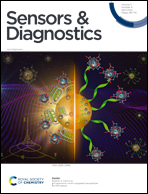Anthracene-(aminomethyl)phenylboronic acid ester-immobilized glass substrates as fluorescent sensing materials based on photo-induced electron transfer for detection and visualization of water†
Abstract
As a reversible and reusable fluorescent material possessing excellent durability for detecting and visualizing moisture and water droplets, we have designed and synthesized a PET (photo-induced electron transfer)-type fluorescent monomer KT-2 composed of anthracene fluorophore-(aminomethyl)-4-cyanophenylboronic acid pinacol ester (AminoMeCNPhenylBPin) with a 3-(triethoxysilyl)propyl group on the amino moiety and achieved preparation of drop-cast poly(KT-2-co-TEOS or GPTMS)silsesquioxane (SQ) films on glass substrates via the sol–gel reaction of KT-2 and tetraethoxysilane (TEOS) or (3-glycidyloxypropyl)trimethoxysilane (GPTMS). KT-2 exhibited enhancement of the fluorescence emission with the increase in water content in various solvents (less polar, polar, protic, and aprotic solvents) due to the formation of the PET inactive (fluorescent) species KT-2W by the interaction with water molecules. The detection limit (DL) of KT-2 for water in the low water content region below 1.0 wt% in the solvents was 0.015–0.020 wt%, indicating that KT-2 can act as a PET-type fluorescent sensor for a trace amount of water in solvents. Indeed, it was found that the poly(KT-2-co-TEOS or GPTMS)SQ films exhibited a reversible fluorescence off–on switching between the PET active state under a dry process and the PET inactive state under a wet process. Actually, the poly(KT-2-co-TEOS or GPTMS)SQ films initially exhibited a weak blue emission under a dry process but visually apparent blue emission upon exposure to moisture (under a wet process). In particular, the poly(KT-2-co-TEOS)SQ film displays superior reversible switching performance with a huge change in the fluorescence intensity in the dry–wet process compared with the poly(KT-2-co-GPTMS)SQ film. This result is attributed to the fact based on the measurements of water contact angles and the roughness on the film surfaces that the poly(KT-2-co-TEOS)SQ film with a pitted uneven structure has large amounts of KT-2 units on the surface which make it possible to form the PET inactive KT-2W structure by the interaction with water molecules. Herein, we propose that PET-type fluorescent sensor-immobilized glass substrates are one of the most promising and convenient functional dye materials based on a fluorescence off–on switching system for detecting and visualizing moisture and water droplets.



 Please wait while we load your content...
Please wait while we load your content...